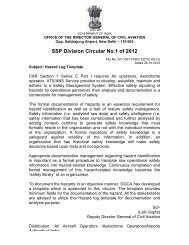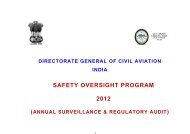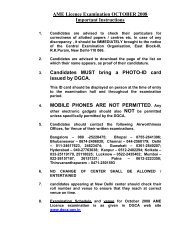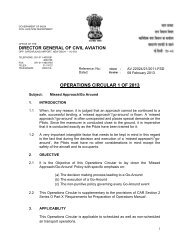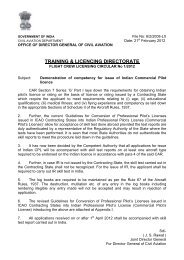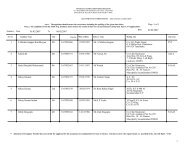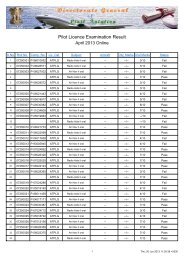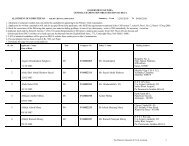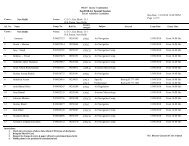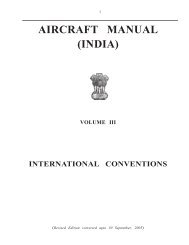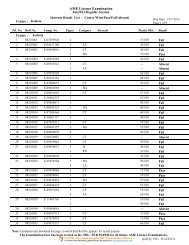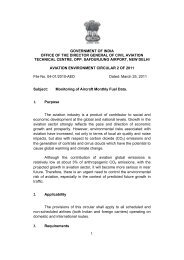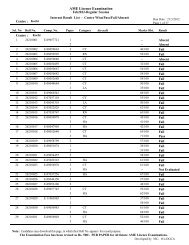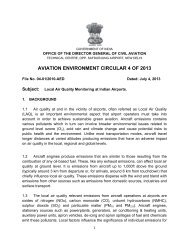ADVISORY CIRCULAR 1 of 2009 FOR AIR OPERATORS Controlled ...
ADVISORY CIRCULAR 1 of 2009 FOR AIR OPERATORS Controlled ...
ADVISORY CIRCULAR 1 of 2009 FOR AIR OPERATORS Controlled ...
Create successful ePaper yourself
Turn your PDF publications into a flip-book with our unique Google optimized e-Paper software.
GOVERNMENT OF INDIACIVIL AVIATION DEPARTMENTOFFICE OF THEDIRECTOR GENERAL OF CIVIL AVIATIONOPP. SAFDARJUNG <strong>AIR</strong>PORT, NEW DELHI – 110 003TELEPHONE: 091-011-46352614644768FAX: 091-011-4644764TELEX: 31-74127TELEGRAMS: <strong>AIR</strong>CIVIL Reference: No.:Dated:AV.22024/3/2007-FID26 March <strong>2009</strong><strong>ADVISORY</strong> <strong>CIRCULAR</strong> 1 <strong>of</strong> <strong>2009</strong><strong>FOR</strong> <strong>AIR</strong> <strong>OPERATORS</strong>Subject:<strong>Controlled</strong> Flight into Terrain1. PURPOSE.This advisory circular (AC) highlights the inherent risk that controlled flight into terrain(CFIT) poses for general aviation (GA) pilots. This AC includes the common definition<strong>of</strong> the term CFIT, identifies some, but not all, <strong>of</strong> the risks associated with GA CFITaccidents, and provides some recommendations and strategies to combat CFIT within theGA community. This AC is not an all-inclusive document on CFIT; rather, this AC isdesigned to help flight instructors and other trainers develop CFIT training materials byidentifying some <strong>of</strong> the factors involved in GA CFIT accidents. Some common referencesare included to aid instructors in preparing CFIT presentations. Pilots can benefit fromreading this AC to check their own knowledge <strong>of</strong> CFIT and factors involved to avoidhaving a GA CFIT accident. This AC will break the study <strong>of</strong> GA CFIT into three broadcategories. One will focus on visual flight rules (VFR) pilots without an instrument ratingoperating in marginal VFR weather conditions (visual meteorological conditions (VMC))or instrument flight rules (IFR) weather conditions (instrument meteorological conditions(IMC. The second category will focus on GA IFR operations in IMC conditions on anIFR flight. The third category will focus on low-flying aircraft operating in VFRconditions.2. BACKGROUND.a. According to DGCA information, general aviation CFIT accidents account for a largepercentage <strong>of</strong> all general aviation fatalities. More than half <strong>of</strong> these CFIT accidentsoccurred during IMC. The DGCA is working in partnership with the community todevelop an action plan and revise guidance material to reduce the incidence <strong>of</strong> CFITwithin the GA segment <strong>of</strong> aviation. However, one <strong>of</strong> the problems in reviewing GA CFIT1
accidents is the lack <strong>of</strong> data, particularly human factors data. Since many <strong>of</strong> the pilotsinvolved in GA CFIT accidents are fatalities and most GA aircraft are not equipped withdata recording systems, the lack <strong>of</strong> GA CFIT accident data will continue to remain aproblem for investigators.b. Although many CFIT accidents have some common factors that are applicable for alltypes <strong>of</strong> aircraft, we want to stress the difference between a crewed aircraft with twopilots in the cockpit and a single-pilot aircraft. In crewed cockpits, the second pilot maymake the difference between a safe flight and a CFIT accident. Conversely, a second pilotcan also be a distraction in certain circumstances unless the crew has been trained to workwell together and is following good crew resource management (CRM) techniques. As ageneral rule <strong>of</strong> thumb, whether an air carrier type aircraft or a GA aircraft, the crewedaircraft is generally better equipped with more safety equipment, such as an autopilot,radar altimeter, or ground proximity warning system (GPWS) onboard, than a typicalsingle-pilot, small GA aircraft.c. Because a single-piloted, small GA aircraft is vulnerable to the same CFIT risks as acrewed aircraft but with only one pilot to perform all <strong>of</strong> the flight and decision-makingduties, that pilot must be better prepared to avoid a CFIT type accident. In some cases, aGA pilot may be more at risk to certain CFIT type accidents because the pilot does nothave the company management or DGCA oversight that a corporate or commercialoperator may be exposed to. Without such oversight, such as detailed standard operatingprocedures and higher mandatory safety requirements, it is the responsibility <strong>of</strong> thesingle-pilot to ensure he or she is well trained, qualified for the intended flight, meets allregulatory requirements for the flight, and has the self-discipline to follow industryrecommended safety procedures that can minimize CFIT type accidents.3. RELATED REFERENCES: RESERVED4. RELATED PUBLICATIONS.a. Advisory Circulars.b. Manuals and Handbooks.c. Checklists.(1) Personal Minimums Checklist, (2) Flight Safety Foundation, CFIT Checklist, Appendix 1, and.e. <strong>Controlled</strong> Flight Into Terrain, Education and Training Aid. Historically, most <strong>of</strong> theresearch related to CFIT accidents and the development <strong>of</strong> recommended safety practices hasbeen done for air carrier type operations. The <strong>Controlled</strong> Flight Into Terrain, Education andTraining Aid, is a good example <strong>of</strong> such research done by industry and government.Produced by the Flight Safety Foundation, the International Civil Aviation Organization(ICAO), and the FAA, the aid provides a good history, lists common dangers, and providessome recommended means <strong>of</strong> combating CFIT accidents for air carrier operations. Inaddition, the document is a valuable resource for anyone developing a CFIT training course.The document is available on the FAA's Internet website at:5. DEFINITIONS.2
a. <strong>Controlled</strong> Flight into Terrain (CFIT). CFIT occurs when an airworthy aircraft isflown, under the control <strong>of</strong> a qualified pilot, into terrain (water or obstacles) withinadequate awareness on the part <strong>of</strong> the pilot <strong>of</strong> the impending collision.b. Loss <strong>of</strong> Control. The term, loss <strong>of</strong> control, refers to emergency situations from whicha pilot may have been able to recover but did not, such as problems with situationawareness, recovery from windshear, mishandling <strong>of</strong> an approach, and recovery from astall.c. Situational Awareness. As used in this AC, situational awareness means the pilot isaware <strong>of</strong> what is happening around the pilot's aircraft at all times in both the vertical andhorizontal plane. This includes the ability to project the near term status and position <strong>of</strong>the aircraft in relation to other aircraft, terrain, and other potential hazards.d. Crewed Aircraft. In this AC, crewed aircraft refers to an aircraft or flight operation inwhich more than one pilot is required by aircraft certification or type <strong>of</strong> operation.e. Single-Pilot Aircraft. In this AC, single-pilot means only one pilot is required by theaircraft certification. Normally, only one pilot flies such an aircraft.6. SCOPE. : In visual meteorological conditions, the pilot in command (PIC) isresponsible for terrain and obstacle clearance whether operating under VFR or IFR.Although this AC addresses the issue <strong>of</strong> pilots operating under VFR in marginal VMC orIMC conditions, the DGCA does not in any way accept or approve <strong>of</strong> pilots operatingVFR in near IMC. The paragraphs dealing with such operations are only designed tohighlight the risks <strong>of</strong> such operations. The DGCA expects pilots to comply with theappropriate flight rules for all flight operations.7. TOP 10 RECOMMENDED INTERVENTION STRATEGIES.The following is a list <strong>of</strong> 10 safety recommendations for GA. GA being “...basicallyeverything except the military and scheduled air carriers.” Although some <strong>of</strong> the safetyrecommendations go beyond the capability <strong>of</strong> instructors or trainers interested indeveloping training materials for GA; CFIT safety presentations or CFIT lesson plans,they all contain information that will improve CFIT safety in flight, on or near airportsand obstructions.The CFIT’s Top 10 Recommended Intervention Strategies.(1) Increase pilot awareness on accident causes.(2) Improve safety culture within the aviation community.(3) Promote development and use <strong>of</strong> a low cost terrain clearance and/or a look aheaddevice.(4) Improve pilot training (i.e., weather briefing, equipment, decision-making, wire andtower avoidance, and human factors.(5) Improve the quality and substance <strong>of</strong> weather briefs.(6) Enhance the flight review and/or instrument competency check.(7) Develop and distribute mountain-flying technique advisory material.(8) Standardize and expand use <strong>of</strong> markings for towers and wires.(9) Use high visibility paint and other visibility enhancing features on obstructions.(10) Eliminate the pressure to complete the flight where continuing may compromisesafety.8. VFR-ONLY PILOTS OPERATING IN MARGINAL VFR or near IMCCONDITIONS.3
a. Operating in marginal VFR/IMC conditions is one <strong>of</strong> the leading causes <strong>of</strong> GA accidents iscontinued VFR flight into IMC. As per regulations ceiling, cloud, or visibility conditions lessthan that specified for VFR or Special VFR is IMC and IFR applies. However, some pilots,including some with instrument ratings, continue to fly VFR in conditions less than thatspecified for VFR. The result is <strong>of</strong>ten a CFIT accident when the pilot tries to continue flyingor maneuvering beneath a lowering ceiling and hits an obstacle or terrain or impacts water.The accident may or may not be a result <strong>of</strong> a loss <strong>of</strong> control before the aircraft impacts theobstacle or surface. The importance <strong>of</strong> complete weather information, understanding thesignificance <strong>of</strong> the weather information, and being able to correlate the pilot's skills andtraining, aircraft capabilities, and operating environment with an accurate forecast cannot beemphasized enough.b. Continued flight in reduced visual conditions compounded by night operations and/oroverwater flight poses some risks. VFR pilots in reduced visual conditions may developspatial disorientation and lose control, possibly going into a graveyard spiral, or descend to anunsafe altitude while trying to maintain visual contact with the surface. The pilot thenimpacts terrain, the surface, or an obstacle while trying to manoeuvre. The following aresome <strong>of</strong> the CFIT risks associated with such flight.(1) Loss <strong>of</strong> aircraft control.(2) Loss <strong>of</strong> situational awareness.(3) Reduced reaction time to see and avoid rising terrain or obstacles.(4) Inability <strong>of</strong> the pilot to operate the aircraft at its minimum controllable airspeed.(5) Getting lost or being <strong>of</strong>f the preplanned flightpath and impacting terrain or obstacle.(6) Reduced pilot reaction time in the event <strong>of</strong> an aircraft maintenance problem because <strong>of</strong> alow or lowering altitude.(7) Failure to adequately understand the weather conditions that resulted in the reducedconditions.(8) Breakdown in good aeronautical decision-making.(9) Failure to comply with appropriate regulations.(10) Failure to comply with minimum safe altitudes.(11) Increased risk <strong>of</strong> hitting one <strong>of</strong> many new low altitude towers installed for cellulartelephones and other types <strong>of</strong> transmissions. This risk is especially great along majorhighways if VFR pilots try to follow a highway when lost or trying to stay under alowering ceiling.(12) Failure to turn around and avoid deteriorating conditions when first able.9. GA IFR OPERATIONS IN IMC CONDITIONS ON AN IFR FLIGHT.These operations also pose special risks. Whether it is failure to follow safe take<strong>of</strong>f anddeparture techniques, recommended en route procedures ― which includes loss <strong>of</strong> situationalawareness ― or failure to manoeuvre safely to a landing, IFR operations can be dangerousfor those not prepared to operate or not current and pr<strong>of</strong>icient in the IMC and IFRenvironments. Many <strong>of</strong> these accidents result in fatalities. Techniques or suggestions foravoiding some <strong>of</strong> these IFR risk factors include:a. Importance <strong>of</strong> the pilot in command being qualified, current, and pr<strong>of</strong>icient for theintended flight.b. Importance <strong>of</strong> the aircraft being properly equipped for the intended flight.c. Having the proper charts and approach plates for the intended flight. VFR charts,although not required, should be onboard because they can provide important obstacleand terrain data for an IFR flight.4
d. Knowing the planned procedure well enough to know if air traffic is issuing an unsafeclearance or if the pilot flying, when a crewed aircraft, is not following the publishedprocedure.e. If in a crewed aircraft, both pilots have adequately briefed the flight and operation <strong>of</strong> theaircraft, including shared responsibilities.f. Having complete weather data for the flight, including knowing where visualmeteorological conditions exist or a safe alternative is since many GA aircraft flown IFRhave limited range or speed to fly out <strong>of</strong> un-forecasted weather conditions.g. Importance <strong>of</strong> maintaining situational awareness, both horizontal and vertical, throughoutthe flight to avoid flying into hazardous terrain or known obstacles.h. Complete knowledge on how to operate all equipment onboard the aircraft. This includesthe limitations and operations <strong>of</strong> new types <strong>of</strong> navigation equipment.i. If a crewed aircraft, the crew is aware <strong>of</strong> and follows the recommended crew resourcemanagement principles. If a single-piloted flight, the pilot knows to use all availableresources including air traffic control to help ensure a safe flight as well as any onboardresource such as a passenger or onboard charts or manuals.j. Pilot in command follows the rules for making a missed approach and is prepared tomake a missed approach when conditions fall below minimums as specified in theregulations, company policy, pilot's personal minimums checklist, or the approachbecomes destabilized.k. Knowledge <strong>of</strong> minimum safe or sector altitudes and <strong>of</strong> the highest terrain in the area.l. Pilot in command is aware <strong>of</strong> the risks involved when transitioning from visual toinstrument or from instrument to visual procedures on take<strong>of</strong>f or landing.m. Pilot in command uses all available safety equipment installed in the aircraft and on theground.n. Pilot in command is aware <strong>of</strong> the risks involved in setting the aircraft's altimeterincluding inherent limitations <strong>of</strong> barometric altimeters.o. Knowing the air traffic control system well enough to be pr<strong>of</strong>icient in it.p. Knowing when not to fly.q. Properly using an installed autopilot, if so equipped, to reduce pilot workload.r. Proper use <strong>of</strong> checklists as outlined in the aircraft manual or if not listed, before reaching1,000 feet above ground level (AGL) to minimize any distractions when operating closeto the ground.s. The importance <strong>of</strong> flying a stabilized approach. A common definition <strong>of</strong> a stabilizedapproach is maintaining a stable speed, descent rate, vertical flightpath, and configurationthroughout the final segment <strong>of</strong> the approach. Although originally designed for turbojetaircraft, a stabilized approach is also recommended for propeller-driven aircraft. The ideais to reduce pilot workload and aircraft configuration changes during the critical finalapproach segment <strong>of</strong> an approach. The goal is to have the aircraft in the proper landingconfiguration, at the proper approach speed, and on the proper flightpath beforedescending below the minimum stabilized approach height. The following arerecommended minimum stabilized approach heights.(1) 500 feet above the airport elevation during VFR weather conditions.(2) MDA or 500 feet above airport elevation, whichever is lower, for a circling approach.(3) 1,000 feet above the airport or touch down zone elevation during IMC.t. The increased CFIT risk <strong>of</strong> nonprecision approaches.u. The increased CFIT risk <strong>of</strong> high descent rates near the ground.v. The importance <strong>of</strong> good communications between the pilot and air traffic controlconcerning any flight instruction or clearance. The old rule <strong>of</strong> asking for clarificationwhenever in doubt about any instruction or clearance applies.5
w. The dangers <strong>of</strong> complacency for the single-pilot, as well as multi-piloted crews, whenmaking routine flights.x. The dangers <strong>of</strong> misunderstanding air traffic control instructions or accepting anincorrect clearance.y. The dangers <strong>of</strong> not knowing the safe altitudes for your en route as well as your terminalarea.10. LOW-FLYING <strong>AIR</strong>CRAFT OPERATING IN VFR CONDITIONS.Although many <strong>of</strong> the factors listed previously apply to low-flying aircraft operating in VFRconditions, this is a special category for those pilots flying below minimum safe altitudes.Such operators include agriculture applicators and helicopter pilots who routinely operatenear trees, telephone lines and power lines, or other such obstacles. In many cases, the pilotwas aware <strong>of</strong> the obstacles but environmental factors such as time <strong>of</strong> day, minimal light,shadows, darkness, sun glare, cockpit blind spots, fatigue, or other such factors resulted in thepilot losing situational awareness and hitting an obstacle or impacting the ground. In somecases, pilots may have been aware <strong>of</strong> an obstacle, but because <strong>of</strong> some <strong>of</strong> these environmentalfactors, they were unable to avoid a collision because they did not see the danger in time orthey saw the danger but failed to react in time to avoid an accident. Density altitude andaircraft performance limitations may also pose risk factors for such flights. These samefactors can also result in a CFIT accident for someone flying in mountainous terrain. Somecommon low altitude CFIT factors are:a. Windshear and loss <strong>of</strong> flying speed.b. Density altitude.c. Failure to operate aircraft within operating limitations.d. Failure to check an area from a safe altitude before descending into it (highreconnaissance and low reconnaissance).e. Flying between hills or over rivers below hill tops can result in a CFIT accident if apower line or cable is strung between the hills. Not all such lines are marked or charted.f. Flying up a box canyon and not being able to fly up and out <strong>of</strong> it before impactingterrain.g. Flying over rising terrain that exceeds an aircraft's ability or performance to climbaway from the terrain.h. Errors in pilot judgement and decision-making.i. Diversion <strong>of</strong> pilot attention.j. Low Flying.k. Crew distractions or a breakdown in crew resource management.l. Operating in an unsafe manner.m. Failure to maintain control <strong>of</strong> the aircraft when taking <strong>of</strong>f or landing.n. Failure to properly pre-plan the flight.o. Operating in unfamiliar areas or depending upon untrained people to provide importantflight data.p. Not having an objective standard to make go-no go decisions for launching.q. Failure to review all available data for the flight (particularly applicable to medicalevacuation flights).r. Lack <strong>of</strong> terrain knowledge and elevation <strong>of</strong> the highest obstacles within your immediateoperating area.s. Failure to properly plan your departure route when departing from unprepared areassuch as helicopters or aircraft operating <strong>of</strong>f an airport. Such factors include weight and6
alance, aircraft performance, height <strong>of</strong> obstacles, wind direction, trees, density altitude,rising terrain, length <strong>of</strong> take<strong>of</strong>f area, and safe abort areas.11 The following list contains many <strong>of</strong> the same factors listed for CFIT accidents. Thislisting <strong>of</strong> major reasons why GA pilots continue to have accidents has remained constantover time. With the possible exception <strong>of</strong> subparagraph f, these factors can all be CFITfactors.a. Inadequate pre-flight preparation and/or planning.b. Failure to obtain and/or maintain flying speed.c. Failure to maintain directional control.d. Improper level <strong>of</strong>f.e. Failure to see and avoid objects or obstructions.f. Mismanagement <strong>of</strong> fuel.g. Improper in-flight decisions or planning.h. Misjudgement <strong>of</strong> distance and speed.i. Selection <strong>of</strong> unsuitable terrain.j. Improper operation <strong>of</strong> flight controls.12. DECIDE MODEL. Many CFIT accident reports discuss the lack <strong>of</strong> good decisionmakingon the part <strong>of</strong> the pilot or flight crew. The following D-E-C-I-D-E model is includedin many manuals and books on decision-making.a. Detect change (or identify problem).b. Estimate significance (<strong>of</strong> the change).c. Choose the (best) objective or outcome.d. Identify options (that meet objective or desired outcome).e. Do best option.f. Evaluate (the outcome--if the outcome is not what is desired then do a new DECIDEmodel).13. TECHNICAL SOLUTIONS.a. The development <strong>of</strong> the first Ground Proximity Warning Systems (GWPS) hascontributed to a marked decline in CFIT accidents in air carrier operations. The use <strong>of</strong>GWPS and the newer generation Terrain Awareness and Warning Systems (TAWS) inGA aircraft have the potential to provide a similar savings in lives and loss <strong>of</strong> GA aircraft.As noted in various CFIT documents, the proper use <strong>of</strong> terrain awareness and warningsystems is important to their effectiveness. Pilots are expected to execute the properemergency escape manoeuvres when their ground warning system activates.b. Regulations mandate the installation <strong>of</strong> terrain awareness warning systems in turbinepoweredaircraft as outlined in the appropriate section. The type <strong>of</strong> operation alsoincludes specific passenger seat requirements/limitations for the operations involved aswell as the required type <strong>of</strong> equipment.c. As digital-mapping systems combined with satellite positioning data become lessexpensive, GA pilots may soon be able to graphically see their horizontal and verticallocation at all times. Expanded situational awareness should help pilots avoid some types<strong>of</strong> CFIT accidents. Then the challenge will be to eliminate descent type CFIT accidentsduring the landing phase <strong>of</strong> flight.14. SUMMARY.7
a. <strong>Controlled</strong> flight into terrain normally occurs at speed with the result that many suchaccidents are fatal. A common thread throughout this AC is the importance <strong>of</strong> properplanning, good decision-making, and being able to safely operate the aircraft throughoutis entire operating range. Since CFIT implies that the aircraft is operating properly, themain reason for such accidents is what is commonly called pilot error. Therefore, it is thepilot's responsibility to ensure that he or she is qualified for the flight, that the aircraft isproperly equipped for the flight, and that the flight is flown according to the appropriateregulations and aircraft operating limitations. According to the CFIT, Education andTraining Aid, about 25.0 percent <strong>of</strong> all accidents occur during the take<strong>of</strong>f and initial climbsegment <strong>of</strong> flight. Approximately 7.0 percent <strong>of</strong> the accidents occur during the climbportion. Only about 4.5 percent occur during cruise. About 19.5 percent occurs duringdescent and initial approach. But 41.4 percent <strong>of</strong> the accidents occur during finalapproach and landing. Take<strong>of</strong>f, initial climb, final approach, and landing represent onlyabout 6.0 percent <strong>of</strong> the total flight time <strong>of</strong> a given flight. But as these numbers point out,that 6.0 percent <strong>of</strong> a flight's total time can most dangerous. Ground proximity warningsystems and the newer terrain awareness and warning systems using GPS have thepotential to reduce CFIT accidents on take<strong>of</strong>fs and landings. These systems provide onemore tool for pilots to use to increase their safety margin when operating close to terrainand obstacles. However, every pilot must know the limitations <strong>of</strong> his or her database andwhat objects are included in the database.b. The solution to combating CFIT accidents starts on the ground. Pilots need to properlyprepare to safely execute the manoeuvres required during take<strong>of</strong>f, initial climb, finalapproach, and landing phases <strong>of</strong> flight. Whether VFR or IFR, each flight has critical flightsegments. How the flight segments are planned for and handled determines, to a greatextent, the safety <strong>of</strong> the flight. Appendix 1, Flight Safety Foundation's CFIT Checklist,provides one example <strong>of</strong> how to calculate CFIT risk. It states, "Use the checklist toevaluate specific flight operations and to enhance pilot awareness <strong>of</strong> the CFIT risk."c. Recommendations.(1) Non-instrument rated VFR pilots should not attempt to fly in IMC.(2) Know and fly above minimum published safe altitudes. VFR: Fly a minimum <strong>of</strong> 1,000feet above the highest terrain in your immediate operating area in non-mountainousareas. Fly a minimum <strong>of</strong> 2,000 feet in mountainous areas.(3) If IFR, fly published procedures. Fly the full published procedure at night, duringminimum weather conditions, or operating at an unfamiliar airport.(4) Verify proper altitude, especially at night or over water, through use <strong>of</strong> a correctly setaltimeter.(5) Verify all ATC clearances. Question an ATC clearance that assigns a heading and/oraltitude that, based upon your situational awareness, places the aircraft in a CFITenvironment.(6) Maintain situational awareness both vertically and horizontally.(7) Comply with appropriate regulations for your specific operation.(8) Don't operate below minimum safe altitudes if uncertain <strong>of</strong> position or ATCclearance.(9) Be extra careful when operating in an area with which you are not familiar with.(10) Use current charts and all available information.(11) Use appropriate checklists.(12) Know your aircraft and its equipment.8
Sd/-Capt. Arvind KathpaliaFlight Operations Inspector9
APPENDIX 1. CFIT CHECKLISTFlight Safety FoundationCFIT ChecklistEvaluate the Risk and Take ActionFlight Safety Foundation (FSF) designed this controlled-flight-into-terrain (CFIT) riskassessmentsafety tool as part <strong>of</strong> its international program to reduce CFIT accidents, whichpresent the greatest risks to aircraft, crews and passengers. The FSF CFIT Checklist is likelyto undergo further developments, but the Foundation believes that the checklist is sufficientlydeveloped to warrant distribution to the worldwide aviation community.Use the checklist to evaluate specific flight operations and to enhance pilot awareness <strong>of</strong> theCFIT risk. The checklist is divided into three parts. In each part, numerical values areassigned to a variety <strong>of</strong> factors that the pilot/operator will use to score his/her own situationand to calculate a numerical total.In Part I: CFIT Risk Assessment, the level <strong>of</strong> CFIT risk is calculated for each flight, sector orleg. In Part II: CFIT Risk-reduction Factors, Company Culture, Flight Standards, HazardAwareness and Training, and Aircraft Equipment are factors, which are calculated in separatesections. In Part III: Your CFIT Risk, the totals <strong>of</strong> the four sections in Part II are combinedinto a single value (a positive number) and compared with the total (a negative number) inPart l: CFIT Risk Assessment to determine your CFIT Risk Score. To score the checklist, usea nonpermanent marker (do not use a ball-point pen or pencil) and erase with a s<strong>of</strong>t cloth.Part I: CFIT Risk AssessmentSection 1- Destination CFIT Risk Factors Value ScoreAirport and Approach Control Capabilities:ATC approach radar with MSAWS ................................ 0 _____ATC minimum radar vectoring charts............................. 0 _____ATC radar only............................................................... -10 _____ATC radar coverage limited by terrain masking............ -15 _____No radar coverage available (out <strong>of</strong> service/not installed).....-30 _____No ATC service......................................................................-30 _____Expected Approach:Airport located in or near mountainous terrain.......................-20 _____ILS............................................................................................ 0 _____VOR/DME..............................................................................-15 _____Nonprecision approach with the approach slope from theFAF to the airport TD shallower than 2 ¾ degrees.................-20 _____NDB ...............................................................................…......-30 _____Visual night “black-hole” approach..........................................-30 _____Runway Lighting:Complete approach lighting system............................................0 _____Limited lighting system.............................................................-30 _____Controller/Pilot Language Skills:Controllers and pilots speak different primary languages.........-20 _____Controllers’ spoken English or ICAO phraseology poor..........-20 _____Pilots’ spoken English poor.......................................................-20 _____Departure:No published departure procedure ..............................…..........-10 _____Destination CFIT Risk Factors Total (-)_____10
115-130 points Tops in company culture105-115 points Good, but not the best Company Culture Total (+)_____80-105 points Improvement neededLess than80 points High CFIT risk12
APPENDIX 1. CFIT CHECKLIST – ContinuedSection 2 - Flight StandardsValueScoreSpecific procedures are written for:Reviewing approach or departure procedures charts...............................10_____Reviewing significant terrain along intendedapproach or departure course.............................…………………….....20_____Maximizing the use <strong>of</strong> ATC radar monitoring........................................10_____Ensuring pilot(s) understand that ATC is using radaror radar coverage exists……………………………..............................20_____Altitude changes......................................................................................10_____Ensuring checklist is complete before initiation <strong>of</strong> approach.................10_____Abbreviated checklist for missed approach............................................10_____Briefing and observing MSA circles on approach chartsas part <strong>of</strong> plate review.....………………………………........................10_____Checking crossing altitudes at IAF positions.........................................10_____Checking crossing altitudes at FAF and glideslope centering................10_____Independent verification by PNF <strong>of</strong> minimum altitudeduring stepdown DME (VORNME or LOC/DME) approach...............20_____Requiring approach/departure procedure charts withterrain in color, shaded contour formats................................................20_____Radio-altitude setting and light-aural (below MDA) forbackup on approach........……………………………….......................10_____Independent charts for both pilots, with adequateLighting and holders.…………………..………...................................10_____Use <strong>of</strong> 500-foot altitude call and other enhancedprocedures for NPA.....………………………......................................10_____Ensuring a sterile (free from distraction) cockpit,especially during IMC/night approach ordeparture..........................................…...................................................10_____Crew rest, duty times and outer considerations especiallyfor multiple-time-zone operation............................................................20_____Periodic third-party or independent audit <strong>of</strong> procedures........................10_____13
Route and familiarization checks for new pilotsDomestic................................................................................................10_____International...........................................................................................20_____Airport familiarization aids, such as audiovisual aids...........................10_____First <strong>of</strong>ficer to fly night or IMC approaches and the captainto monitor the approach........................................................................20_____Jump-seat pilot (or engineer or mechanic) to helpmonitor terrain clearance and the approach in IMC or nightconditions....................................................……………......................20_____Insisting that you fly the way that you train........................................25_____300-335 points Tops in CFIT flight standards270-300 points Good, but not the best Flight Standards Total(+)_____200-270 points Improvement neededLess than 200 High CFIT riskSection 3 - Hazard Awareness and Training Value ScoreYour company reviews training with the training departmentor training contractor..............…………………………………........10_____Your company’s pilots are reviewed annually about the following:Flight standards operating procedures................................................20_____Reasons for and examples <strong>of</strong> how the procedurescan detect a CFIT “trap”....................………………........30_____Recent and past CFIT incidents/accidents..............................................50_____Audiovisual aids to illustrate CFIT traps................................................50_____Minimum altitude definitions for MORA, MOCA,MSA, MEA, etc......………………………………………...................15_____You have a trained flight safety <strong>of</strong>ficer who rides the jumpseat occasionally..…………………………………..............................25_____You have flight safety periodicals that describe andanalyze CFIT incidents..................…………………………..............10_____You have an incident/exceedance review andreporting program.....……………………............................................20_____Your organization investigates every instance in whichminimum terrain clearance has been compromised ............................20_____14
APPENDIX 1. CFIT CHECKLIST – ContinuedYou annually practice recoveries with GPWS in the simulator .....................40_____You train the way that you fly.....................................................................…25_____285-315 points Tops in CFIT training250-285 points Good, but not the best Hazard Awareness and Training Total(+)_____190-250 points Improvement neededLess than 190 High CFIT riskSection 4 – Aircraft EquipmentValueScoreRadio altimeter with cockpit display <strong>of</strong> full2,500-foot range - captain only......................…………………………............20_____Radio altimeter with cockpit display <strong>of</strong> full2,500-foot range - copilot..........…………………………...............................10_____First-generation GPWS......................................................................................20_____Second-generation GPWS or better...................................................................30_____GPWS with all approved modifications, data tables and servicebulletins to reduce false warnings.…………....................................................10_____Navigation display and FMS............................................................................10_____Limited number <strong>of</strong> automated altitude callouts................................................10_____Radio-altitude automated callouts for nonprecisionapproach (not heard on ILS approach) and procedure......................................10_____Preselected radio altitudes to provide automated calloutsthat would not be heard during normal nonprecision approach........................10_____Barometric altitudes and radio altitudes to giveautomated “decision” or “minimums” callouts...........................….................10_____An automated excessive “bank angle” callout..................................................10_____Auto flight/vertical speed mode.......................................................................-10_____Auto flight/vertical speed mode with no GPWS........................…..................-20_____GPS or other long-range navigation equipment tosupplement NDB-only approach.......................................................................15_____Terrain-navigation display................................................................................20_____15
Ground-mapping radar.....................................................................................10_____175-195 points Excellent equipment to minimize CFIT risk155-175 points Good, but not the best Aircraft Equipment Total(+)_____*115-155 points Improvement neededLess than 115 High CFIT riskCompany Culture ______ + Flight Standards ______ + Hazard Awareness and Training______+Aircraft Equipment = CFIT Risk-reduction Factors Total (+)________*If any section in Part II scores less than “Good,” a thorough review is warranted <strong>of</strong>that aspect <strong>of</strong> the company's operation.Part III: Your CFIT RiskPart I CFIT Risk Factors Total (-)______+ Part II CFIT Risk-reduction Factors Total(+)_____= CFIT Risk Score (±)______A negative CFIT Risk Score indicates a significant threat; review the sections in Part IIand determine what changes and improvements can be made to reduce CFIT risk.In the interest <strong>of</strong> aviation safety, this checklist may be reprinted in whole or in part, but credit must be given toFlight Safety Foundation.16



